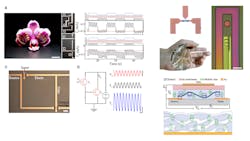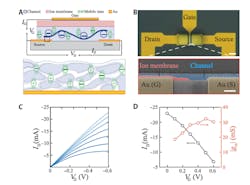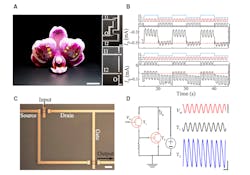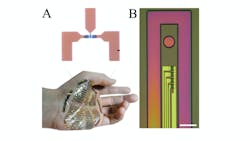No “Solid State” Here: These Transistors are Organic and Biocompatible
This article appeared in Electronic Design and has been published here with permission.
We generally associate the term “semiconductor” with the phrase “solid state” as if they’re the same thing. That makes sense, given that our industry’s literal and figurative foundations are usually based on solid physical elements such as silicon, geranium, and gallium. Nonetheless, a whole world of “organic” transistors has attracted considerable attention and has little relation to those in the solid state.
Recently, a multidisciplinary research team at Columbia University developed ion-driven organic transistors that are designed to record individual neurons and perform real-time computation. These biocompatible devices could enable better diagnosis and monitoring of neurological diseases.
Professor Dion Khodagholy, who directs the university’s Translational NeuroElectronics Lab, noted “Instead of having large implants encapsulated in thick metal boxes to protect the body and electronics from each other, such as those used in pacemakers, and cochlear and brain implants, we could do so much more if our devices were smaller, flexible and inherently compatible with our body environment.”
Silicon-based devices can’t function in the presence of ions and water; they need to be encapsulated in the body. Further, as electron-based devices, they don’t interact well with the ionic signals that the body’s cells use to communicate. Some organic materials have been developed to overcome these limits, but their electrical performance has been inadequate for the target applications.
In this project, the ionic conduction of organic materials is used to create ion-driven transistors from a composite of poly(2,3-dihydrothieno-1,4-dioxin)-poly(styrenesulfonate) (designated as PEDOT:PSS) and polyethylenimine (PEI). These enhancement-mode, internal ion-gated organic electrochemical transistors (e-IGTs) have embedded mobile ions inside their channels (Fig. 1).
1. Structure and steady-state characteristics of IGT: (A) Schematic illustration of IGT cross-section and wiring diagram for device operation (top); d-sorbitol creates an ion reservoir, maintaining mobile ions (green) that can travel within the channel. PEDOT-rich regions are shown in light blue and PSS lamellas (flakes) in white (bottom). (B) Optical micrograph displaying the top view of an individual transistor (scale bar, 20 µm). Inset shows a cross-sectional scanning electron microscopy (SEM) image acquired at a tilt angle of 30°. Ion membrane (light red), channel (light blue), and Au contacts for gate (G) and source (S; beige) are visible (scale bar, 5 µm). (C) Output characteristics (ID − VD) of IGT device (L = 5 µm, W = 500 µm) for gate voltage (VG) varying from 0 V (top curve) to +0.6 V (bottom curve) with a step of +0.1 V; color intensity corresponds to VG amplitude. (D) Transfer curve for VD = −0.6 V (black), and the corresponding transconductance (orange), |gmmax| = 32.30 mS. (Source: Columbia University)
Since the ions don’t need to travel long distances to be a part of in the channel switching process, they can be switched on and off quickly and efficiently. This results in devices with high transconductance and fast speed that can be independently gated to create scalable conformable integrated circuits.
They used these e-IGTs to acquire a wide range of electrophysiological signals, such as in-vivo recording of neural action impulses, and to create soft, biocompatible, long-term implantable neural processing units for the real-time detection of epileptic discharges (Fig. 2).
2. Integrated IGT-based digital logic gates and cascaded amplifiers: (A) IGT-based NAND and NOR gates conform to the surface of orchid petals (left) (scale bar, 1 cm). Optical micrographs of NOR (top right) and NAND (bottom right) logic gates. Input (I1 and I2) and output (O) configuration is indicated (scale bar, 100 µm). (B) Temporal response of the output (O) drain current of a NOR (top) and a NAND (bottom) logic gate. First input signal (I1, blue), second input signal (I2, red), and output signal (O, black) are shown at the top. Dashed red lines mark the threshold of high and low logics. (C) Optical micrograph displaying the top view of an IGT-based cascaded amplifier (scale bar, 20 µm). (D) Circuit diagram of IGT-based cascaded amplifier and the corresponding input and output signals. Input voltage, Vin, (red) (scale bar, 50 mV). Output signal from T1 (black). Final amplified output from T2 (blue) (scale bars, 50 µA and 100 ms). (Source: Columbia University)
Extending their basic research, the team also created a mixed-conducting particulate (MCP) material that’s capable of performing multiple, nonlinear, dynamic electronic functions just by varying the size and density of its composite particles. These high-performance anisotropic films incorporate independently addressable transistors, resistors and diodes that are pattern-free, scalable, and biocompatible.
The material enables the creation of complex electronic components that traditionally require several layers and materials. It also enables easy and effective electronic bonding between soft materials, biological tissue, and rigid electronics. With its controllable electronic properties, MCP can non-invasively record muscle action potentials from the surface of an arm (Fig. 3) or monitor large-scale brain activity during neurosurgical procedures, such as implanting deep-brain stimulation electrodes.
3. Conformable enhancement-mode, internal ion-gated organic electrochemical transistor (e-IGT): (A) Micrograph displaying the top view of an e-IGT (top) (scale bar, 5 mm). Ultra-flexible, ultra-thin e-IGT array conforming to the surface of a human hand (bottom). (B) Optical micrograph of an e-IGT-based device with four transistors for LFP and spike recording. The anchor hole facilitates insertion of the conformable device into deep layers of cortex (scale bar, 80 mm). (Source: Columbia University)
The researchers maintain that the base materials for these e-IGTs and MCPs are readily available and inexpensive. Prof. Khodagholy added that the next step is to transform these components into functional, long-term implantable devices that can record and modulate brain activity to help patients with neurological diseases such as epilepsy.
The work is detailed in two papers published almost simultaneously in different journals. Focused on the e-IGT, “Enhancement-mode ion-based transistor as a comprehensive interface and real-time processing unit for in vivo electrophysiology” is in Nature Materials (an unlocked version is here) and bolstered by Supplementary Information and this video:
“Mixed-conducting particulate composites for soft electronics” concentrates on the MCP and is published in AAAS Science Advances, along with Supplementary Materials and this video:



